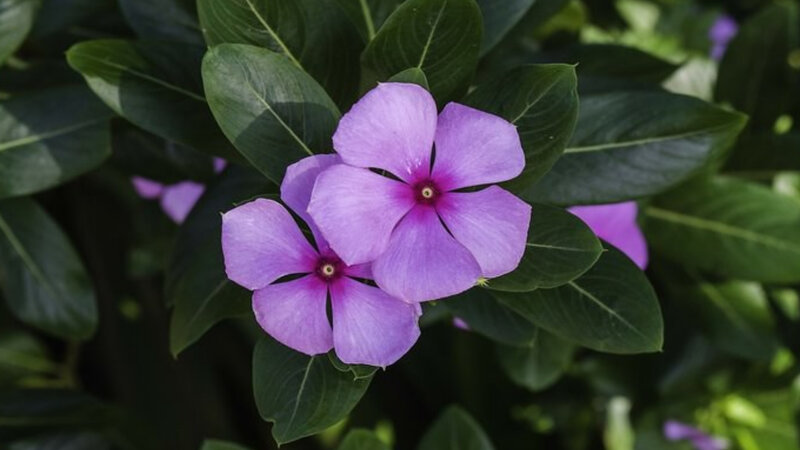Periwinkle Plant – Medicinal Uses Of Leaves & Flowers In Ayurveda
What is the periwinkle plant? A Periwinkle is a very common plant that is found in India. Periwinkle is also known as “Sadapushpa” or “Sadaabahar”.

It is botanically named Catharanthus roseus and belongs to the Apocynaceae family. It is a shrub that grows to a height of 1-3 feet having smooth, glossy, dark green leaves, and flowers throughout the year.
This plant is known by three names such as Myrtle, Vinca, and Periwinkle (or Madagascar periwinkle). The Botanists have separated strain or variety of Periwinkle.
The Periwinkle flowers are found in different colors such as blue, purple, violet pink, and white. The Vinca plants are native to North America, Europe, China, and India.
Almost all parts of the periwinkle plant have medicinal properties. Among all periwinkle plants, two varieties have been grown for medicinal properties they are pink and white in color flowers Periwinkle has a dark pink eye in the center.
Ayurvedic View on Periwinkle
According to the principles of Ayurveda, this plant increases the dryness of tissues and is light to digest. In Ayurvedic medicine, the leaves, seeds, flowers, and roots are used for the treatment of diabetes, Alzheimer’s, cancer, and menorrhagia.
It is also effective in leukemia so-called “raktarbuda” in Ayurveda. It relieves Vata and Kapha so it can be used effectively in the management of the diseases related to Vata/ Kapha or Vata – Kapha origin.
The paste of leaves is used to apply on wounds that occur due to insect bites. The antibacterial and antivenom qualities of the plant heal the wound faster.
Key Actions of Periwinkle
(a)Periwinkle
- Bitter in taste
- Hot potency
(b) Vinca Major & Vinca Minor
- Astringent
- Hypotensive
- Hypoglycemic
- Stops bleeding
(b) Madagascar Periwinkle
- Hypoglycemic
- Anticancer agent
Periwinkle plant has about 86 alkaloids extracted from plants in the Vinca genus. The chemotherapy agent known as vincristine is extracted from Vinca rosea (Catharanthus roseus) is used to treat diseases such as diabetes, leukemias, high blood pressure, lymphomas, stroke, and childhood cancers as well as several other types of cancer and some non-cancerous conditions.
Medicinal Uses Of Periwinkle Plant
Periwinkle plant has been used around the world for more than a century as food, medicine, decoration, garlands, etc. Scott Cunningham an author of “Cunningham’s Encyclopedia of Magical Herbs,” has mentioned many uses of periwinkle.
In Europe, it is used for snake bites, a remedy for poison and to protect against wild beasts, the evil eye, and spirits. In the 17th century, an herbalist named Dr. Nicholas Culpepper had recommended periwinkle leaves to treat to reduce heavy menstrual bleeding.
Besides this, he also recommended bleeding in the mouth, nose and also suggested married couples should eat periwinkle leaves as it “cause love between them”. The other uses of periwinkle for various chronic diseases are given below.
1. Reduce diabetes risk factors
Scientists have already started experimentation to look at the anti-diabetic and hypoglycemic properties of periwinkle leaves. The researchers in Bangladesh of Mymensingh Medical College investigated the effects of Madagascar periwinkle in diabetic rats.
They have found that Madagascar periwinkle had a significant effect on controlling the levels of blood sugar. The study was published in the “Mymensingh Medical Journal” in 2007.
The research shows that strong hypoglycemic (is a condition characterized by an abnormally low level of blood sugar) effects were seen in both diabetic and non-diabetic rats.
The researchers confirmed that the properties of greater periwinkle may be useful in treating diabetes, but more research is needed to test the effects and safety of the plant in humans.
2. Reverse memory loss
The leaves and seeds of the periwinkle contain vincamine, a precursor to the chemical vinpocetine, which is a powerful free radical scavenger. Vinpocetine is used as medicine to enhance memory in aging minds.
Vincamine is a chemical extract in a supplement form, but the herbalists advise the whole herb to be used in either tea or extract form by using the whole herb one can receive the balanced blend of healing properties that are found naturally in this plant.
Vinpocetine may also help to prevent senility and dementia by preventing damage to the blood vessels in the brain that are caused by free radicals. Vinpocetine thins the blood as well as boosts circulation to the brain.
It improves the brain’s ability to absorb nutrients that improve brain function. A study published in 2005, it stated that Periwinkle and vinpocetine are found to be very useful for the treatment of many brain diseases, especially stroke recovery.
It has been used in Europe and Japan as a natural therapy for stroke, as it helps to increase blood flow to areas of the brain with minimal function.
3. Reduce the risk of Alzheimer’s
Vinpocetine is a chemical derived from vincamine, which is found in the leaves of common periwinkle as well as the seeds of various African plants.
It is used as a treatment for memory loss and mental impairment. It has shown some benefits to people who were associated with Alzheimer’s disease symptoms.
In a preliminary study, it was found that vincamine itself has shown to be beneficial in a later double-blind trial. In Europe, Vincopetine medicine is sold in the name of Cavinton and in the US it is also sold as a dietary supplement.
4. Fight against cancer
The periwinkle plant has properties such as vincristine and vinblastine that are believed to be effective in fighting against cancer. Vincristine and vinblastine bind to tubulin protein in cellular microtubules by preventing polymerization and striking cellular division by killing the cell.
These properties may also exert immunosuppressant activity which may interfere with other components of the cell cycle to induce cellular death.
Vincristine and vinblastine are also used for the treatment of leukemia, Hodgkin’s disease, Wilms tumor, neuroblastoma, malignant lymphomas, Kaposi’s sarcoma, and mycosis fungoides, and many other related diseases.
Dosage
The researchers and experts have not yet specified the particular doses of periwinkle, but pure alkaloids vincristine and vinblastine are used in cancer therapy as single weekly IV doses of 0.05 to 0.15 mg/kg and 0.1 to 0.2 mg/kg respectively.
How To Make Periwinkle Tea
- To make periwinkle tea you need 2 teaspoons of dried herbs (which is a mixture of leaf, flower, stem, root, etc.)
- Pour boiling water into the cup and let it steep for about10-15 minutes once it is done, strain to remove the herbs, and your cup of periwinkle tea is ready.
- You can add adding honey or fruit juice to your cup if the taste is too bitter for you.
- You must drink periwinkle tea in the morning before breakfast or it may upset your stomach.
Periwinkle Tea Side Effects
With so many health benefits, periwinkle tea has to have a few side effects too. Here are some which you must have to be careful with.
- You should avoid drinking periwinkle tea if you’ve got liver, kidney, or lung diseases. You should not drink it if you’ve got ailments such as constipation or low blood pressure.
- There is a strict warning for pregnant women to drink periwinkle tea, as it may lead to birth defects or even miscarriages. The breastfeeding mother must also stay away from this tea like this in this case may affect the baby.
- It is not advised to people to drinking periwinkle tea before surgery and after surgery. Maybe it can low blood pressure and it might lead to problems during and after the surgery. Consult your doctor and make sure you’re safe to drink periwinkle tea after surgery.
- Drinking more than 4 cups of periwinkle tea is not recommended. The usual symptoms such as low blood pressure, constipation, and other symptoms such as headaches, loss of appetite, insomnia, dizziness, and irregular heartbeats are seen in the people drinking tea.
WARNING – Periwinkles are members of the Dogbane family many members of these are big-time poisonous when ingested. So if you are going to try internal concoctions made at home, do it with extreme caution and in extreme moderation.
“NOTE: This herb has to be consumed only under the supervision of a qualified doctor. It should not be used directly as it is extremely toxic and may cause damage to the liver, kidneys and nerves and in some cases it may result in death as well.”



























Vinca minor or periwinkle is an excellent evergreen plant which can be used as decorative plant for a shady or semi-shady spot. There are different varieties such as White, blue or maroon flowers they appear in early spring and continue blooming intermittently throughout the summer.
The source of the most commonly used chemotherapy drugs is the simple Periwinkle plant.